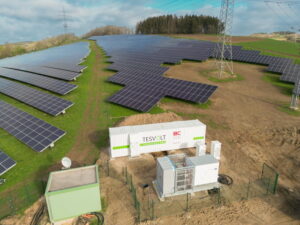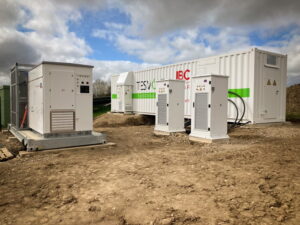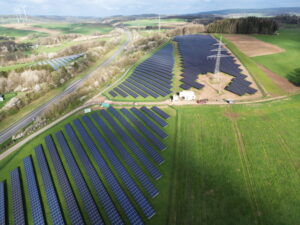The Eifelkreis Bitburg-Prüm is a district in the far west of Rhineland-Palatinate, bordering Belgium and Luxembourg. In terms of area, the district is the largest and also the least populated in Rhineland-Palatinate. This is also due to the fact that parts of the district belong to the Südeifel Nature Park and the German-Luxembourg Nature Park. One focus of the nature park’s work is the development and implementation of projects to promote the experience of nature and the countryside, sustainable regional development and nature conservation. This also includes projects that support the production and use of sustainable energy – such as the new solar park with connected battery storage, which has been in operation since June 2024.
The solution from IBC SOLAR combines a solar park with an installed capacity of 2.5 megawatt peak (MWp) with a 2.5 MWh battery storage system. The project in Weinsfeld has also been awarded the innovation subsidy under the German Renewable Energy Sources Act (EEG).
50 times more energy in the same area
The district, with its strong links to the nature park and nature conservation, was an early adopter of renewable energy concepts. Here too, the possibilities and particularly sustainable and efficient approaches have evolved.
An area of 2.5 hectares was used for the new solar park, which was previously used to grow maize for a biogas plant in intensive farming. On the one hand, the solar park was designed in harmony with the nature reserve and fulfils all nature conservation requirements in the region. At the same time, it can generate a fifty-fold higher energy yield compared to the previous maize cultivation.
Intelligent control enables contribution to grid stability
The area available for power generation was not only optimally utilised by the design of the solar park. IBC SOLAR combined the photovoltaic system with a generously dimensioned battery storage system in order to make the energy generated as usable as possible for feeding into the energy grid.
Due to the limited grid capacity, peak loads from renewable energies are always an issue. This should therefore be taken into account when planning large solar parks, which generate a particularly large amount of energy around midday. An ideal solution is to combine solar parks with energy storage systems.
With the help of an intelligent control system, the entire area of the PV system can be used to generate electricity. This is because at times when a particularly large amount of solar energy is generated, it can be stored in the storage system. This allows load peaks to be absorbed and does not affect the grid connection capacity. The feed-in can thus be controlled according to demand.
 High economic efficiency through PV + storage
High economic efficiency through PV + storage
The low-loss DC-coupled storage system, a Tesvolt TPS-E 2496 kWh, is connected to a 30 kV grid connection point. With the aim of achieving particularly high availability of the storage system and for communication with the grid and the direct marketer, a generously dimensioned storage system was chosen.
The entire system must also fulfil high technical requirements. For example, the execution of permanent control commands ensures that the power limitation at the connection point is adhered to and fulfils all requirements of the Medium Voltage Directive.
With the combination of powerful solar and storage solutions, the park achieves a particularly high level of efficiency. This is because it can continuously produce the maximum possible electricity yield without throttling or switching off during peak loads. By temporarily storing electricity and postponing its feed-in to the grid until the hours of low production, the operator can achieve a particularly high level of remuneration.
